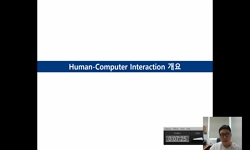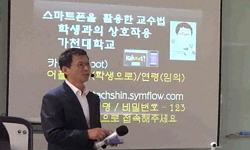Aristoteles, in Poetics, said that the art is embodied through an imitation of nature and placed a meaning on the essence of art form. In this respect, artists have been trying to enhance the experience of viewers on art works by integrating the relat...
http://chineseinput.net/에서 pinyin(병음)방식으로 중국어를 변환할 수 있습니다.
변환된 중국어를 복사하여 사용하시면 됩니다.
- 中文 을 입력하시려면 zhongwen을 입력하시고 space를누르시면됩니다.
- 北京 을 입력하시려면 beijing을 입력하시고 space를 누르시면 됩니다.

미디어아트에서 모방론에 관한 연구-<화인(化人)>을 중심으로- = A Study on the Theory of Mimesis in Media Art -Focused on <Fine>-
한글로보기https://www.riss.kr/link?id=A103796617
- 저자
- 발행기관
- 학술지명
- 권호사항
-
발행연도
2014
-
작성언어
Korean
- 주제어
-
등재정보
KCI등재
-
자료형태
학술저널
- 발행기관 URL
-
수록면
279-289(11쪽)
-
KCI 피인용횟수
2
- 제공처
-
0
상세조회 -
0
다운로드
부가정보
다국어 초록 (Multilingual Abstract)
Aristoteles, in Poetics, said that the art is embodied through an imitation of nature and placed a meaning on the essence of art form. In this respect, artists have been trying to enhance the experience of viewers on art works by integrating the relationship between nature and human into the work. According to John Dewey, who emphasized that art works can maintain the aesthetic standing only through the human experiences, today’s media art which induces viewers’ voluntary participation and tactile experience, can be referred as the art pursuing the most active experience. Media art has been developed by imitating or combining the previous art forms using digital media. The course of art work using digital media follows the theme of traditional art that dealt with the essence of human and nature, or changes the viewers’ experience from passive state to active with the interactive relationship between the artwork and viewers. In this way, Media Art imitates a traditional art form and aesthetic categories of subjects and at the same time expands the new concept by changing the art form with different mediums and tools. In this sense, this study analyzes through case work how the embodiment process – that began from the relationship between human and nature, nature and art, and human and art - is implemented in today’s media art. This study also present the media art work, Fine, which generates active human experience with the subject of nature and analyzes the interactive relationship between human and nature that is formed in the work.Aristoteles, in Poetics, said that the art is embodied through an imitation of nature and placed a meaning on the essence of art form. In this respect, artists have been trying to enhance the experience of viewers on art works by integrating the relationship between nature and human into the work. According to John Dewey, who emphasized that art works can maintain the aesthetic standing only through the human experiences, today’s media art which induces viewers’ voluntary participation and tactile experience, can be referred as the art pursuing the most active experience. Media art has been developed by imitating or combining the previous art forms using digital media. The course of art work using digital media follows the theme of traditional art that dealt with the essence of human and nature, or changes the viewers’ experience from passive state to active with the interactive relationship between the artwork and viewers. In this way, Media Art imitates a traditional art form and aesthetic categories of subjects and at the same time expands the new concept by changing the art form with different mediums and tools. In this sense, this study analyzes through case work how the embodiment process – that began from the relationship between human and nature, nature and art, and human and art - is implemented in today’s media art. This study also present the media art work, Fine, which generates active human experience with the subject of nature and analyzes the interactive relationship between human and nature that is formed in the work.
국문 초록 (Abstract)
아리스토텔레스는 시학에서 예술은 자연의 모방을 통해 형상화된다고 하였으며, 예술 행위의 본질에 대하여 의미를 두고 있다. 이러한 점에서 예술가들은 자연과 인간의 관계를 소재로 하...
아리스토텔레스는 시학에서 예술은 자연의 모방을 통해 형상화된다고 하였으며, 예술 행위의 본질에 대하여 의미를 두고 있다. 이러한 점에서 예술가들은 자연과 인간의 관계를 소재로 하여 작품 안에 통합함으로써, 관객들의 작품 감상 경험을 강화시키려는 노력을 계속해 왔다. 예술작품은 사람의 경험을 통해서만 미적 상태(aesthetic standing)를 가질 수 있다고 주장한 존 듀이에 따라 관객의 자발적 참여와 통감각적인 경험을 유발시키는 최근의 미디어아트는 가장 적극적인 경험을 추구하는 예술이라고 볼 수 있다. 미디어 아트는 디지털 매체를 이용한 작품으로 이전의 예술형식을 모방하거나 많은 부분 결합하는 형태로 발전하여 왔다. 디지털 매체를 이용한 작업의 과정은 자연과 인간에 대한 본질을 다루어 왔던 전통 예술의 주제를 답습하거나 더 적극적으로 작품과 관객과의 상호작용적 관계를 활용하여 관객의 경험을 수동적인 상태에서 능동적인 경험의 장으로 이루어지고 있다. 이와 같이 미디어아트는 기존의 예술이 가졌던 미적 형식과 주제의 범주를 모방하는 동시에 매체와 도구에 따라 형태를 달리하며 새로운 개념을 확장한다고 볼 수 있다. 이러한 관점에서 본 연구는 자연과 인간, 자연과 예술, 인간과 예술의 관계에서 시작된 예술의 형상화 작업이 최근의 미디어아트에서 어떻게 구현이 되는지를 사례작품들을 통해 분석하였다. 또한 자연을 소재로 하여 인간의 경험을 능동적으로 발생 시키는 미디어아트 작품화인(化人)을 제작하고, 작품 안에서 형성되는 대체 자연과 관객의 상호작용의 관계를 분석하였다.
참고문헌 (Reference)
1 김춘일, "조형의 기초와 분석" 미진사 2006
2 朴愛正, "자연의 형상화를 시도한 섬유예술작품 : 작품제작을 중심으로" 이화여자대학교 대학원 1985
3 양지현, "인터랙티브 미디어아트에서 비언어적커뮤니케이션에 관한 연구 : 점자의 형상화 작품<공감>을 중심으로" 숭실대학교 대학원 2012
4 미셀 푸코, "이것은 파이프가 아니다" 민음사 1995
5 김진엽, "예술이란 무엇인가? -현대 영미미학의 답변들" 한국미학예술학회 16 : 139-156, 2002
6 멜빈 레이더, "예술과 인간가치" 까치 2004
7 임정미, "서양 고대 그리스의 모방론에서 본 춤 예술" 한국체육철학회 18 (18): 247-259, 2010
8 손진석, "사운드에 반응하는 시청각적인 인터랙티브 아트에 관한 연구" 한국만화애니메이션학회 (35) : 329-346, 2014
9 랜덜 패커, "멀티미디어" 나비프레스 2004
10 크리스티안 폴, "디지털 아트" 시공아트 2007
1 김춘일, "조형의 기초와 분석" 미진사 2006
2 朴愛正, "자연의 형상화를 시도한 섬유예술작품 : 작품제작을 중심으로" 이화여자대학교 대학원 1985
3 양지현, "인터랙티브 미디어아트에서 비언어적커뮤니케이션에 관한 연구 : 점자의 형상화 작품<공감>을 중심으로" 숭실대학교 대학원 2012
4 미셀 푸코, "이것은 파이프가 아니다" 민음사 1995
5 김진엽, "예술이란 무엇인가? -현대 영미미학의 답변들" 한국미학예술학회 16 : 139-156, 2002
6 멜빈 레이더, "예술과 인간가치" 까치 2004
7 임정미, "서양 고대 그리스의 모방론에서 본 춤 예술" 한국체육철학회 18 (18): 247-259, 2010
8 손진석, "사운드에 반응하는 시청각적인 인터랙티브 아트에 관한 연구" 한국만화애니메이션학회 (35) : 329-346, 2014
9 랜덜 패커, "멀티미디어" 나비프레스 2004
10 크리스티안 폴, "디지털 아트" 시공아트 2007
11 발터벤야민, "기술복제 시대의 예술작품 사진의 작은 역사 외" 길 2007
12 존 듀이, "경험으로서의 예술" 책세상 2013
13 DALE CHIHULY, "MILLE FIORI" 2012
동일학술지(권/호) 다른 논문
-
프레데릭 J. 키슬러 전시공간의 상호현실주의·바이오테크닉 특성 연구
- 한국기초조형학회
- 이성연
- 2014
- KCI등재
-
뇌(腦) 메커니즘에 기초한 아동 심리와 그림 특징 연구
- 한국기초조형학회
- 백중열
- 2014
- KCI등재
-
소피 칼(Sophie Calle)의 작품을 통해 본 내러티브(narrative)의 조형적 효과에 관한 분석
- 한국기초조형학회
- 서정배
- 2014
- KCI등재
-
스마트폰 액세서리 디자인에 나타난 아날로그 감성 특성에 관한 연구
- 한국기초조형학회
- 유상원
- 2014
- KCI등재
분석정보
인용정보 인용지수 설명보기
학술지 이력
| 연월일 | 이력구분 | 이력상세 | 등재구분 |
|---|---|---|---|
| 2027 | 평가예정 | 재인증평가 신청대상 (재인증) | |
| 2021-01-01 | 평가 | 등재학술지 유지 (재인증) |  |
| 2018-01-01 | 평가 | 등재학술지 유지 (등재유지) |  |
| 2015-02-09 | 학술지명변경 | 외국어명 : Bulletin of Korean Society of Basic Design & Art -> Journal of Basic Design & Art |  |
| 2015-01-01 | 평가 | 등재학술지 유지 (등재유지) |  |
| 2011-01-01 | 평가 | 등재학술지 유지 (등재유지) |  |
| 2009-01-01 | 평가 | 등재학술지 유지 (등재유지) |  |
| 2006-01-01 | 평가 | 등재학술지 선정 (등재후보2차) |  |
| 2005-01-01 | 평가 | 등재후보 1차 PASS (등재후보1차) |  |
| 2003-01-01 | 평가 | 등재후보학술지 선정 (신규평가) |  |
학술지 인용정보
| 기준연도 | WOS-KCI 통합IF(2년) | KCIF(2년) | KCIF(3년) |
|---|---|---|---|
| 2016 | 0.33 | 0.33 | 0.34 |
| KCIF(4년) | KCIF(5년) | 중심성지수(3년) | 즉시성지수 |
| 0.34 | 0.34 | 0.512 | 0.08 |




 KCI
KCI DBpia
DBpia






